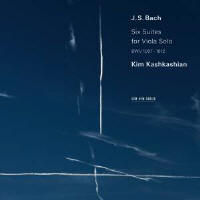Texte paru dans: / Appeared in: |
|
|
Outil de traduction (Très approximatif) |
|
|
Reviewer: Rob Cowan Performing Bach’s Cello Suites in a transcription for viola is nothing new. Among other viola versions that I have to hand, Lillian Fuchs recorded all six for American Decca years ago (a CD reissue is available from Doremi), William Primrose set five of them down in his later years (occasionally flawed performances that ring true in purely musical terms; Biddulph) and there’s Nobuko Imai’s admirable Philips set which, in general terms, compares well with Kashkashian, though the latter’s wider tonal palette and sense of fantasy often incline me in her direction. With Kashkashian, there’s an invariable tendency to sing out, an appealing ease of movement, and when we reach the written rest within bar 48 of the Prelude to the D minor Suite, Khashkashian – like Yo-Yo Ma on his most recent version of the cello original (Sony, A/18) – makes the gesture pregnant with meaning. Nobuko Imai treads a straighter path; and then there’s Fuchs, with her consistent vibrato and warmth of tone, very much a style of yesteryear but extremely beautiful, building inexorably towards that rest, stressing the chord that precedes it, the whole process more eventful than the rest itself. Kashkashian I think nails the passage from the standpoint of a superior stylistic balance. To mention just a handful of additional observations that I noted while listening to this latest set, in Kashkashian’s hands the opening measures of the Menuet of the G major Suite are colourfully articulated, the initial phrase which ends on a trill (bars 1‑4) warmly rounded, its successor (bars 7‑8) more assertive. Then there’s a small rest before the embellished repeat. With Imai, Kashkashian’s most apposite rival, there’s no pause, no embellishment for the repeat and less in the way of colouristic variation. Then, in the closing Gigue, Kashkashian expressively slows the pace just after the beginning, whereas Imai keeps to her initial tempo. Her playing is rather more formal and forceful than Kashkashian’s whereas, in viola-playing terms, I couldn’t imagine a more dignified or sublimely expressed account of the C minor’s Prelude than Kashkashian’s. Imai’s closely recorded option is more grainy, a little halting too, although it is superbly played. Kashkashian eases into the single-line fugal section with such natural facility that you could hardly imagine it being better done. Her handling of the oftexcerpted Sarabande has a winning sense of stillness about it, whereas Imai, taking a significantly slower tempo, lays the music on a thicker carpet of tone. Fuchs’s vibrant, singing line provides another manner of musical seduction. As to the Gavotte sequence from the Sixth Suite, the pitch is lower on Imai’s version, while Kashkashian handles this delightful movement with the lightest touch. By comparison, Fuchs’s obdurate forcefulness won’t appeal to all; but, as I’ve already suggested, her playing has a real sense of purpose, Casals I would imagine having provided some sort of interpretative template. Viewed overall, Kashkashian delivers handsomely on all fronts and I extend a warm welcome to her expertly engineered new set, which is much enhanced by a typically imaginative roster of illustrations and superb notes by Paul Griffiths. |
|




